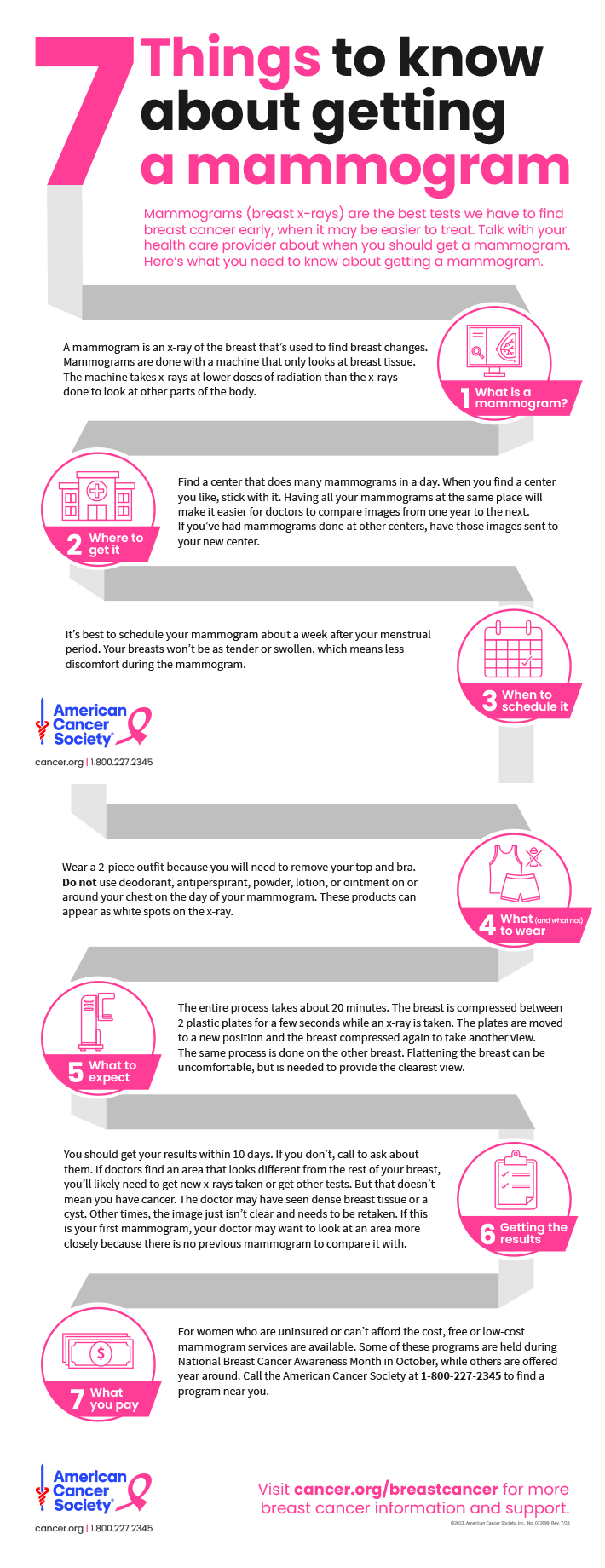Your gift is 100% tax deductible
7 Things to Know About Getting a Mammogram
A mammogram is an x-ray of the breast that looks for changes that may be signs of breast cancer. Getting regular screening with a mammogram is the most reliable way to find breast cancer early. Breast cancer that's found early, when it's small and has not spread, is easier to treat successfully.
Women between 40 and 44 should have the option to start screening with a mammogram every year. Women 45 to 54 should get mammograms every year. Women 55 and older can switch to a mammogram every other year, or they can choose to continue yearly mammograms.
- Infographic
- Text Alternative

Mammograms (breast x-rays) are the best tests we have to find breast cancer early, when it may be easier to treat. Talk with your health care provider about when you should get a mammogram. Here’s what you need to know about getting a mammogram.
1. What is a mammogram?
A mammogram is an x-ray of the breast that’s used to find breast changes. Mammograms are done with a machine that only looks at breast tissue. The machine takes x-rays at lower doses of radiation than the x-rays done to look at other parts of the body.
2. Where to get it
Find a center that does many mammograms in a day. When you find a center you like, stick with it. Having all your mammograms at the same center will make it easier for doctors to compare images from one year to the next. If you’ve had mammograms done at other centers, have those images sent to your new center.
3. When to schedule it
It’s best to schedule your mammogram about a week after your menstrual period. Your breasts won’t be as tender or swollen, which means less discomfort during the mammogram.
4. What (and what not) to wear
Wear a 2-piece outfit because you will need to remove your top and bra. Do not use deodorant, antiperspirant, powder, lotion, or ointment on or around your chest on the day of your mammogram. These products can appear as white spots on the x-ray.
5. What to expect
The entire process takes about 20 minutes. The breast is compressed between 2 plastic plates for a few seconds while an x-ray is taken. The plates are moved to a new position and the breast is compressed again to take another view. The same process is done on the other breast. Flattening the breast can be uncomfortable but is needed to provide the clearest view.
6. Getting the results
You should get your results within 10 days. If you don’t, you should call to ask about them. If doctors find an area that looks different from the rest of your breast, you’ll likely need to get new x-rays taken or get other tests. But that doesn’t mean you have cancer. The doctor may have seen dense breast tissue or a cyst. Other times, the image just isn’t clear and needs to be retaken. If this is your first mammogram, your doctor may want to look at an area more closely because there is no previous mammogram to compare it with.
7. What you pay
For women who are uninsured or can’t afford the cost, free or low-cost mammogram services are available. Some of these programs are held during National Breast Cancer Month in October, while others are offered year-round. Call the American Cancer Society at 1-800-227-2345 to find a program near you.
Visit cancer.org/breastcancer for more breast cancer information and support.
American Cancer Society Emails
Sign up to stay up-to-date with news, valuable information, and ways to get involved with the American Cancer Society.



